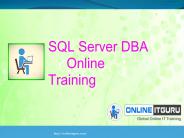11.5 SQL Performance Tuning - PowerPoint PPT Presentation
Title:
11.5 SQL Performance Tuning
Description:
11.5 SQL Performance Tuning Evaluated from client perspective Most current relational DBMSs perform automatic query optimization at the server end – PowerPoint PPT presentation
Number of Views:203
Avg rating:3.0/5.0
Title: 11.5 SQL Performance Tuning
1
11.5 SQL Performance Tuning
- Evaluated from client perspective
- Most current relational DBMSs perform automatic
query optimization at the server end - Most SQL performance optimization techniques are
DBMS-specific - Rarely portable
- Majority of performance problems related to
poorly written SQL code - Carefully written query usually outperforms a
poorly written query
2
Index Selectivity
- Indexes are used when
- Indexed column appears by itself in search
criteria of WHERE or HAVING clause - Indexed column appears by itself in GROUP BY or
ORDER BY clause - MAX or MIN function is applied to indexed column
- Data sparsity on indexed column is high
- Index selectivity is a measure of how likely an
index will be used in query processing
3
Index Selectivity (continued)
- General guidelines for indexes
- Create indexes for each attribute in WHERE,
HAVING, ORDER BY, or GROUP BY clause - Do not use in small tables or tables with low
sparsity - Declare primary and foreign keys so optimizer can
use indexes in join operations - Declare indexes in join columns other than PK/FK
4
Conditional Expressions
- Normally expressed within WHERE or HAVING clauses
of SQL statement - Restricts output of query to only rows matching
conditional criteria
5
- Common practices for efficient SQL
- Use simple columns or literals in conditionals
- Avoid functions
- Numeric field comparisons are faster
- than character, date, and NULL comparisons
- Equality comparisons faster than inequality
- the slowest is LIKE comparison
- Transform conditional expressions to use literals
- Write equality conditions first
- AND Use condition most likely to be false first
- OR Use condition most likely to be true first
- Avoid NOT
6
11.6 Query Formulation
- Identify what columns and computations are
required (p.459) - Expressions
- Aggregate functions
- Granularity of raw required
- Identify source tables
- Determine how to join tables
- Determine what selection criteria is needed
- Simple comparison? IN? Nested Comparison? HAVING
- Determine in what order to display output
7
11.7 DBMS Performance Tuning
- Includes managing DBMS processes in primary
memory and structures in physical storage - DBMS performance tuning at server end focuses on
setting parameters used for - Data cache large enough
- SQL cache same query may be submitted by many
users - Sort cache
- Optimizer mode
8
DBMS Performance Tuning
- Some general recommendations for creation of
databases - Use RAID (Redundant Array of Independent Disks)
to provide balance between performance and fault
tolerance - Minimize disk contention
- At least with the following table spaces system
table, user table, index table, temporary table,
rollback segment table - Put high-usage tables in their own table spaces
- Assign separate data files in separate storage
volumes for indexes, system, high-usage tables
9
DBMS Performance Tuning
- Some general recommendations for creation of
databases (continued) - Take advantage of table storage organizations in
database - An indexed organized table stores the end user
table and the index table in consecutive
locations on permanent storage - Partition tables based on usage
- Use denormalized tables where appropriate
- Store computed and aggregate attributes in tables
10
Common RAID Configurations
11
11.8 Query Optimization Example
- Example illustrates how query optimizer works
- Based on QOVENDOR and QOPRODUCT tables
- Uses Oracle SQLPlus (Skip)
12
????? SQL Server ???
13
(No Transcript)
14
- Check the differences in query plan
- Before UPDATE STATISTICS QOVENDOR
- After UPDATE STATISTICS QOVENDOR
- 3. CREATE INDEX QOV_NDX1 on QOVENDOR
(V_AREACODE) - UPDATE STATISTICS QOVENDOR
- 4. CREATE INDEX QOV_NDX2 on QOVENDOR (V_NAME)
- UPDATE STATISTICS QOVENDOR
15
(No Transcript)
16
(No Transcript)
17
(No Transcript)
18
(No Transcript)
19
- Check the differences in query plan
- Before UPDATE STATISTICS QOPRODUCT
- After UPDATE STATISTICS QOPRODUCT
- 3. CREATE INDEX QOP_NDX2 ON QOPRODUCT(P_PRICE)
- UPDATE STATISTICS QOPRODUCT
20
Summary
- Database performance tuning
- Refers to activities to ensure query is processed
in minimum amount of time - SQL performance tuning
- Refers to activities on client side to generate
SQL code - Returns correct answer in least amount of time
- Uses minimum amount of resources at server end
- DBMS architecture represented by processes and
structures used to manage a database
21
Summary (continued)
- Database statistics refers to measurements
gathered by the DBMS - Describe snapshot of database objects
characteristics - DBMS processes queries in three phases parsing,
execution, and fetching - Indexes are crucial in process that speeds up
data access
22
Summary (continued)
- During query optimization, DBMS chooses
- Indexes to use, how to perform join operations,
table to use first, etc. - Hints change optimizer mode for current SQL
statement - SQL performance tuning deals with writing queries
that make good use of statistics - Query formulation deals with translating business
questions into specific SQL code































